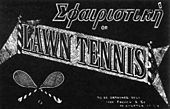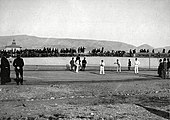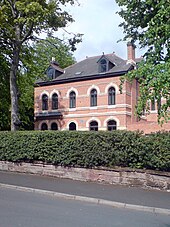Tennis
The racket sport traditionally named lawn tennis, invented in Edgbaston, Warwickshire, England, now commonly known simply as tennis, is the direct descendant of what is now denoted real tennis or royal tennis, which continues to be played today as a separate sport with more complex rules.
Most rules of (lawn) tennis derive from this precursor and it is reasonable to see both sports as variations of the same game. Most historians believe that tennis originated in the monastic cloisters in northern France in the 12th century, but the ball was then struck with the palm of the hand, hence the name jeu de paume (lit. 'game of the palm').[1] It was not until the 16th century that rackets came into use and the game began to be called 'tennis'. It was popular in England and France, and Henry VIII of England was an enthusiast of the game, now referred to as real tennis.[2]
Many original tennis courts remain, including courts at Oxford, Cambridge, Falkland Palace in Fife where Mary Queen of Scots regularly played, and Hampton Court Palace. Many of the French courts were decommissioned with the terror that accompanied the French Revolution. The Tennis Court Oath (Serment du Jeu de Paume) was a pivotal event during the first days of the French Revolution; it was a pledge signed by 576 of the 577 members from the Third Estate who were locked out of a meeting of the Estates-General on 20 June 1789.
Marylebone Cricket Club's Rules of Lawn Tennis have been official, with periodic slight modifications, ever since 1875. Those rules were adopted by the All England Lawn Tennis and Croquet Club for the first lawn tennis championship, The Championships, Wimbledon in 1877.
The Davis Cup, an annual competition between men's national teams, dates to 1900.[3] The analogous competition for women's national teams, the Fed Cup, was founded as the Federation Cup in 1963 to celebrate the 50th anniversary of the founding of the International Tennis Federation, also known as the ITF.
Promoter C. C. Pyle created the first professional tennis tour in 1926, with a group of American and French tennis players playing exhibition matches to paying audiences.[4][5] The most notable of these early professionals were the American Vinnie Richards and the Frenchwoman Suzanne Lenglen.[4][6] Players turning pro could not compete in the major (amateur) tournaments.[4]
In 1968 commercial pressures and rumours of some amateurs taking money under the table led to the abandonment of this distinction, inaugurating the Open Era, in which all players could compete in all tournaments and top players were able to make their living from tennis. With the beginning of the Open Era, the establishment of an international professional tennis circuit, and revenues from the sale of television rights, tennis's popularity has spread worldwide, and the sport has shed its upper/middle-class English-speaking image[7] (although it is acknowledged that this stereotype still exists).[7][8][9]
Etymology
[edit]The word tennis came into use in English in the mid-14th century from French, via the Anglo-Norman term Tenez, which can be translated as 'hold!', 'receive!' or 'take!', a call from the server to his opponent indicating that he is about to serve.[10] The first known appearance of the word in English literature is by poet John Gower in his poem titled 'In Praise of Peace' dedicated to King Henry IV and composed in 1400; "Of the tenetz to winne or lese a chase, Mai no lif wite er that the bal be ronne". (Whether a chase is won or lost at tennis, Nobody can know until the ball is run).[a][12][13][14][15]
Origin
[edit]
Tennis is mentioned in literature as far back as the Middle Ages. In The Second Shepherds' Play (c. 1500) shepherds gave three gifts, including a tennis ball, to the newborn Christ. Sir Gawain, a knight of King Arthur's round table, plays tennis against a group of 17 giants in The Turke and Gowin (c. 1500).[16][17]
Real tennis
[edit]The Medieval form of tennis is termed as real tennis, a game that evolved over three centuries from an earlier ball game played around the 12th century in France that involved hitting a ball with a bare hand and later with a glove.[18][19] By the 16th century the glove had become a racquet, the game had moved to an enclosed playing area and the rules had stabilized. Real tennis spread in popularity throughout royalty in Europe, reaching its peak in the 16th century.
In 1437 at the Blackfriars, Perth, the playing of tennis indirectly led to the death of King James I of Scotland, when the drain outlet, through which he hoped to escape assassins, had been blocked to prevent the loss of tennis balls.[20] James was trapped and killed.[21]
Francis I of France (1515–1547) was an enthusiastic player and promoter of real tennis, building courts and encouraging play among the courtiers and commoners. His successor, Henry II (1547–59), was also an excellent player and continued the royal French tradition. In 1555 an Italian priest, Antonio Scaino da Salothe, wrote the first known book about tennis, Trattato del Giuoco della Palla. Two French kings died from tennis related episodes—Louis X of a severe chill after playing and Charles VIII after hitting his head during a game.[22] King Charles IX granted a constitution to the Corporation of Tennis Professionals in 1571, creating the first pro tennis 'tour', establishing three professional levels: apprentice, associate, and master. A professional named Forbet wrote and published the first codification of the rules in 1599.[23]
Royal interest in England began with Henry V (1413–22). Henry VIII (1509–47) made the biggest impact as a young monarch, playing the game with gusto at Hampton Court on a court he had built in 1530. It is believed that his second wife, Anne Boleyn, was watching a game when she was arrested and that Henry was playing when news of her execution arrived. During the reign of James I (1603–25) London had 14 courts.[24]



Real tennis is mentioned in literature by William Shakespeare, who mentions "tennis balles" in Henry V (1599), when a basket of them is given to King Henry as a mockery of his youth and playfulness; the incident is also mentioned in some earlier chronicles and ballads.[25] One of the most striking early references appears in a painting by Giambattista Tiepolo entitled The Death of Hyacinth (1752–1753), in which a strung racquet and three tennis balls are depicted. The theme of the painting is the mythological story of Apollo and Hyacinth, written by Ovid. Giovanni Andrea dell'Anguillara translated it into Italian in 1561 and replaced the ancient game of discus in the original text with pallacorda or tennis, which had achieved a high status at the courts in the middle of the 16th century. Tiepolo's painting, displayed at the Museo Thyssen Bornemisza in Madrid, was ordered in 1752 by German count Wilhelm Friedrich Schaumburg Lippe, who was an avid tennis player.
The game thrived among the 17th-century nobility in France, Spain, Italy and the Austro-Hungarian Empire but suffered under English Puritanism. By the Age of Napoleon the royal families of Europe were besieged and real tennis was largely abandoned.[26] Real tennis played a minor role in the history of the French Revolution, through the Tennis Court Oath, a pledge signed by French deputies on a real tennis court, which formed a decisive early step in starting the revolution.
An epitaph in St Michael's Church, Coventry, written circa 1705 read, in part:[27]
Here lyes an old toss'd Tennis Ball:
Was racketted, from spring to fall,
With so much heat and so much hast,
Time's arm for shame grew tyred at last.
In England, during the 18th and early 19th centuries as real tennis declined, three other racquet sports emerged: racquets, squash racquets and lawn tennis (the modern game).
Birth of lawn tennis
[edit]

The lawyer and memoirist William Hickey recalled that in 1767 "in the summer we had another club, which met at the Red House in Battersea fields, nearly opposite Ranelagh.... The game we played was an invention of our own, and called field tennis, which afforded noble exercise.... The field, which was of sixteen acres in extent, was kept in as high an order, and smooth as a bowling green."[28]
The modern sport is tied to two separate inventions.
Between 1859 and 1865, in Birmingham, England, Major Harry Gem, a solicitor, and his friend Augurio Perera, a Spanish merchant, combined elements of the game of racquets and a ball of wind and played it on a croquet lawn in Edgbaston.[29][30] In 1872, both men moved to Leamington Spa and in 1874, with two doctors from the Warneford Hospital, founded the world's first tennis club, the Leamington Tennis Club.[31]
In December 1873 Major Walter Clopton Wingfield designed an hourglass-shaped tennis court in order to obtain a patent on his court (as the rectangular court was already in use and was unpatentable). A temporary patent on this hourglass-shaped court was granted to him in February, 1874, which he never renewed when it expired in 1877. It is commonly believed, mistakenly, that Wingfield obtained a patent on the game he devised to be played on that type of court, but in fact Wingfield never applied for nor received a patent on his game, although he did obtain a copyright — but not a patent — on his rules for playing it. And, after a running series of articles and letters in the British sporting magazine The Field, and a meeting at London's Marylebone Cricket Club, the official rules of lawn tennis were promulgated by that Club in 1875, which preserved none of the aspects of the variations that Wingfield had dreamed up and named Sphaeristikè (Greek: σφαιριστική, that is, "sphere-istic", an ancient Greek adjective meaning "of or pertaining to use of a ball, globe or sphere"), which was soon corrupted to "sticky". Wingfield claimed that he had invented his version of the game for the amusement of his guests at a weekend garden party on his estate of Nantclwyd, in Llanelidan, Wales in 1874, but research has demonstrated that even his game was not likely played during that country weekend in Wales.[32][33] He had likely based his game on both the evolving sport of outdoor tennis and on real tennis. Much of modern tennis terminology also derives from this period, for Wingfield and others borrowed both the name and much of the French vocabulary of real tennis, and applied them to their variations of real tennis.[34] In the scholarly work Tennis: A Cultural History, Heiner Gillmeister reveals that on 8 December 1874, Wingfield had written to Harry Gem, commenting that he had been experimenting with his version of lawn tennis for a year and a half.[35] Gem himself had largely credited Perera with the invention of the game.